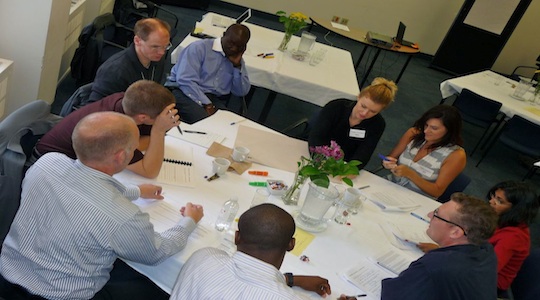
Set up for success: A leader is needed to provide direction and guidance throughout the development process. To ensure the leader is well-accepted, a supervisor should not appoint a team leader; instead, the team should nominate and agree upon which member should assume that role.
When planning a team training event, development plan or learning cascade the 5 Stages of Team Development is a useful tool to consider.
Teams learn, develop and progress through five different stages of development. These include forming, storming, norming, performing and adjourning. Here I summarize the five stages and identify the expected outcomes and challenges.
Forming
- A group of people come together to accomplish a shared purpose.
- High dependence on the leader for guidance and direction.
- Little agreement on team aims other than received from leader. Individual roles and responsibilities are unclear.
- Leader must be prepared to answer lots of questions about the team’s purpose, objectives and external relationships.
- Members test tolerance of system and leader.
- Little ownership that this is their group. Leader directs.
Storming
- Disagreement about mission, vision, and approaches combined with the fact that team members are getting to know each other can cause strained relationships and conflict.
- Decisions don’t come easily within group. Team members vie for position as they attempt to establish themselves in relation to other team members and the leader, who might receive challenges from team members.
- Clarity of purpose increases as goals and expectations are outlined, but plenty of uncertainties persist.
- Cliques and factions form and there may be power struggles.
- Resistance to losing individuality and becoming a group.
- The team needs to be focused on its goals to avoid becoming distracted by relationships and emotional issues.
- Compromises may be required to enable progress. Leader coaches.
Norming
- The team has consciously or unconsciously formed working relationships that are enabling progress on the team’s objectives.
- There is an acceptance of working in a team and the quirks of other team members.
- Agreement and consensus forms among team, who respond well to facilitation by leader.
- Roles and responsibilities are clear and accepted.
- Big decisions are made by group agreement.
- Smaller decisions may be delegated to individuals or small teams within group.
- Commitment and unity is strong.
- The team may engage in fun and social activities.
- The team discusses and develops its processes and working style and members feel that they now have a voice.
- There is general respect for the leader and some of leadership is more shared by the team. Leader facilitates.
Performing
- Relationships, team processes, and the team’s effectiveness in working on its objectives are synching to bring about a successfully functioning team.
- The team is more strategically aware; the team knows clearly why it is doing what it is doing.
- The team has a shared vision and is able to stand on its own feet with no interference or participation from the leader.
- There is a focus on over-achieving goals, and the team makes most of the decisions against criteria agreed with the leader.
- The team has a high degree of autonomy.
- Disagreements occur but now they are resolved within the team positively and necessary changes to processes and structure are made by the team.
- The team is able to work towards achieving the goal, and also to attend to relationship, style and process issues along the way. team members look after each other.
- The team requires delegated tasks and projects from the leader.
- The team does not need to be instructed or assisted.
- Team members might ask for assistance from the leader with personal and interpersonal development. Leader delegates and oversees.
Adjourning
- The team has completed its mission or purpose and it is time for team members to pursue other goals or projects.
- Members may go through separation anxiety.
- If the group experience has been positive there will be a letting go and grieving process.
- Members may need help in moving on. Leader facilitates the letting go process and discusses ways to apply the learning to outside situations.
Understanding these five stages of team development and implementing these suggestions can help ensure teams have the necessary skills and tools to move through each phase, especially the storming phase, and to ensure successful outcomes and growth.

Set up for success: The team leader must redirect the team toward the end goal, help reinforce defined roles, address unacceptable behaviors, provide feedback, and facilitate team communication.
Related Readings: Workshop Structure To Maximize Learner Engagement
Original source material: Bruce Tuckman’s 5 stages of team development. Adapted by John Zeus.













February 15, 2013
Collaborations, Shared Leadership, Success, Training and Team Development